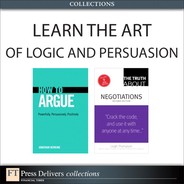Truth 29. The framing principle
A. $10,000 for sure
or
B. A 50–50 chance of winning $20,000 or nothing
This tantalizing proposition is an approach–approach conflict because both options are pretty attractive. (We’d like both of them!) However, we have a little bit of an internal conflict in choosing because as much as we would like to get $20,000, there is a 50 percent chance that we would walk away with nothing. When most people are given the A or B choice, the large majority choose A. (About 85 percent of the students in my MBA and executive courses would rather have $10,000 for sure than a 50–50 chance of winning twice as much money.)
This phenomenon illustrates a basic tenet of human behavior called risk aversion. When it comes to choosing among attractive courses of action, most people would rather have a bird in the hand than go beating around the bush.
When it comes to choosing among attractive courses of action, most people would rather have a bird in the hand than go beating around the bush.
However, let’s turn the tables around. Imagine that someone has you at gunpoint in a dark alley, late at night, and offers you the following choice:
C. Lose $10,000
or
D. Submit to a 50–50 chance of losing $20,000 or nothing
(To make this seem more real, imagine that this person has the ability to extract this money from you.)
This is an avoidance–avoidance conflict because neither option is attractive. In fact, both options suck. However, you are being held at gunpoint, and you have to choose. The majority of people in this situation choose the gamble—in other words, they opt to flip the coin and take a risk that they might lose a huge sum of money, but they might not end up losing anything. This behavior illustrates a basic tenet of human behavior called risk-seeking behavior.
But now we have a conundrum: How can people be both risk averse and risk seeking?
This is where Nobel Prize–winning psychologist Daniel Kahneman of Princeton University comes to the rescue. According to Amos Tversky and Daniel Kahneman, whether people avoid or embrace risk depends upon how the problem or decision is framed.13 When people are asked to make approach–approach decisions (that is, choosing a sure good thing or a gamble that might lead to something much more attractive), most people are risk averse. However, if that same problem is framed as an avoidance–avoidance problem, the tables turn and people are much more likely to gamble!
Indeed, almost any decision in our lives can be framed as a gain or a loss relative to something. Quite frankly, our point of reference for defining gains and losses is pretty arbitrary. A reference point defines what a person considers to be a gain or a loss. Savvy negotiators know how to frame the offers they make to the other party by carefully selecting points of reference.
Indeed, almost any decision in our lives can be framed as a gain or a loss relative to something.
Max Bazerman, Tom Magliozzi, and Margaret Neale demonstrated the powerful framing effecting negotiation. They told some negotiators that they should try to “cut their losses”; they told other negotiators that they should try to “maximize their gains.”14 However, in both cases, their objective financial situations were completely identical. In other words, the only difference was how the negotiators framed their own financial situation.
Bazerman, Magliozzi, and Neale expected that the negotiators who were told to cut their losses would behave a lot like the person confronted in the dark alley: In other words, they would behave in a much more risk-seeking fashion. That is what happened: Negotiators who were put the mindset of cutting their losses made fewer concessions in the negotiation and reached more impasses than did negotiators who were told to maximize their gains. In short, these negotiators took a gamble by refusing all offers in hand and decided on a risky course of action that involved walking away from a sure deal (in hopes of a better deal!).
This effect clearly shows that negotiators who have the mindset of minimizing their losses adopt more risky bargaining strategies, preferring to hold out for a better but more risky settlement. In contrast, negotiators who are told to maximize their gains are more likely to take the bird in the hand.
Obviously, it is in your best interest to put your opponent in a “gain” frame. This will increase the chance that the opponent will take your offer. If the counterparty views your proposal as a loss, he will do something risky, like stalking out of the room.
The framing effect is a powerful, two-edged sword: You can frame others, but you can also be framed! So, before any negotiation, think about your reference points!
